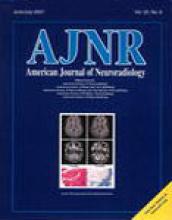Abstract
BACKGROUND AND PURPOSE: Hepatic encephalopathy in cirrhotic patients may be the clinical manifestation of disturbed cerebral cell volume homeostasis. The aim of this study was to investigate the presence of significant changes in magnetization transfer ratio (MTR) values, which could reflect an increase in free water within the brain of patients with liver cirrhosis, and to correlate these findings with minimal hepatic encephalopathy and proton MR spectroscopy (1H-MRS) abnormalities.
METHODS: Twenty-four patients with liver cirrhosis and eight healthy control volunteers were included in the study. MR imaging studies included conventional T1- and T2-weighted imaging, 1H-MRS, and magnetization transfer imaging. MTR and 1H-MRS values were obtained from normal-appearing white matter and were correlated with each other and with the presence of minimal hepatic encephalopathy.
RESULTS: 1H-MRS showed a decrease in choline and myo-inositol and an increase in glutamine + glutamate with respect to creatine + phosphocreatine. MTR values were significantly decreased in cirrhotic patients when compared with healthy control volunteers, although this decrease was not significantly higher in the patients with minimal hepatic encephalopathy. The decreases in MTR values correlated with increases in glutamine + glutamate.
CONCLUSION: The MTR decrease in patients with liver cirrhosis may be caused by low-grade astrocytic swelling produced as a response to the osmotic stress occurring in these patients. However, in this cross-sectional study, we did not find a correlation between MTR decrease and the presence of minimal hepatic encephalopathy, probably because of limitations in MTR quantification techniques.
- Copyright © American Society of Neuroradiology












